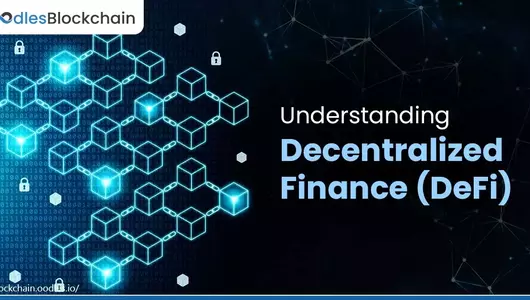-
With the increasing adoption of emerging technologies like blockchain, smart contracts, and cryptocurrency, the concept of decentralized finance (DeFI) is also gaining considerable attention. In this blog, we will explore how these technologies lay the foundation for DeFi, a new exciting financial shift of our time.
Decentralized Finance (DeFI)
Essentially, DeFi addresses the challenges of traditional centralized financial systems and fintech solutions. Unlike centralized systems involving various intermediaries, decentralized financial services eliminate the dependence of any central authority for services like borrowing, lending, and trading with distributed ledger technology like blockchain. Blockchain-fintech services remain independent of any central authority involvement in any transaction governance.
DeFi vs. Centralized Finance
Let’s gain a detailed understanding of the potential of DeFi in improving the current financial landscape. DeFi improves upon our current centralized infrastructure by utilizing the advantages of blockchain technology and smart contract solutions as the underlying infrastructure and using cryptocurrency for transactions. It facilitates autonomy, which enables only users of a DeFi ecosystem to own their assets and no intermediary or centralized authority. Due to being decentralized, there is no provision for freezing users' accounts, seizing your assets, or blocking your transactions. Regarding regulatory compliance, blockchain’s permission and permissionless applications and smart contract solutions play crucial roles in ensuring the adherence to requirements. Unlike centralized systems, with blockchain solutions- DeFi enables service providers and users to easily check the reserves of a DeFi financial system, shop around for genuine loan rates, or even track the transactions of public figures.
DeFi and Fintech | Getting Into Details
You may find DeFi similar to the financial technology concept, which also aims to use technology for improving financial services. However, there is a key difference between DeFi and Fintech. It is that Fintech merely builds upon traditional financial infrastructure, while DeFi uses emerging tech like blockchain technology.
For instance, a fintech service like international payments service charges lower fees than most banks and currency exchange companies. However, it still uses intermediaries like banks, third parties like payment service providers, and other traditional financial infrastructure. Unlike the traditional cross-border transaction system that transfers money across borders, it establishes bank accounts in different countries for money transfers. In this case, you still have to trust the service provider to approve and execute the transaction. Moreover, you also need to seek permission to transfer your money abroad. In most cases, you need to provide identification documents to send money to the recipient.
On the contrary, a DeFi product like stablecoin development with Ethereum blockchain can mirror the value of the US dollar to provide protection against the volatile nature of cryptocurrencies. With stablecoin, there’s no need to trust a Fintech company or bank for transaction approval or settlement. The process completes in around less than 20 seconds, instead of in days with traditional financial infrastructure. Anyone can send stablecoin to anyone with a wallet that supports stable coins. even if they live in countries with no established financial system.
DeFi Use Cases
Providing DeFi services proves cost-effective, secure, and efficient. DeFi enables unbanked people across countries to access efficient and cost-effective financial services. DeFi service providers can offer them near-instantaneous loans without requiring any bank approval or paperwork. They can also enable stock issuance for a company without involving bankers or lawyers who charge exorbitant fees. Additionally, they can build a peer-to-peer exchange for digital assets with additional security and efficiency layers of blockchain and smart contracts.
Lending and Borrowing
DeFi lending and borrowing platforms are popular kinds of DeFi projects. These platforms enable anyone to lend or borrow with appropriate crypto assets used as collateral.
Decentralized Exchanges (DEXes)
Decentralized crypto exchange development, or DEXes, emulate centralized crypto exchange services in a decentralized manner. Instead of relying on a centralized exchange to store money and execute your transactions, DEXes enables users to manage their funds with smart contracts and cryptocurrency wallets. DEX users can retain control of their assets without involving an intermediary. The smart contract functionality automatically matches up buyers and sellers.
However, DEXes still need to gain traction by providing better transaction speeds and user interfaces.
Open Marketplaces
A Decentralized marketplace is another type of DeFi project. It follows the concept of a marketplace that enables people to exchange goods and services with a decentralized architecture.
On open marketplaces built with blockchain, users can buy and sell crypto-collectibles, also known as NFTs or non-fungible tokens. An Ethereum blockchain solution development with smart contracts manages all the buying and selling in an effective and secure manner. It means users gain control over their items, which is contrary to the concept of centralized platforms like Amazon. They act as intermediaries between buyers and sellers while also dictating the rules of the marketplace.
Essentially, open marketplaces bring the idea of traditional markets and true peer-to-peer commerce into realization.

Our Offices
INDIA
Emaar Digital Greens, Sector 61,
Gurugram, Haryana
122011.
Welldone Tech Park,
Sector 48, Sohna road,
Gurugram, Haryana
122018.














